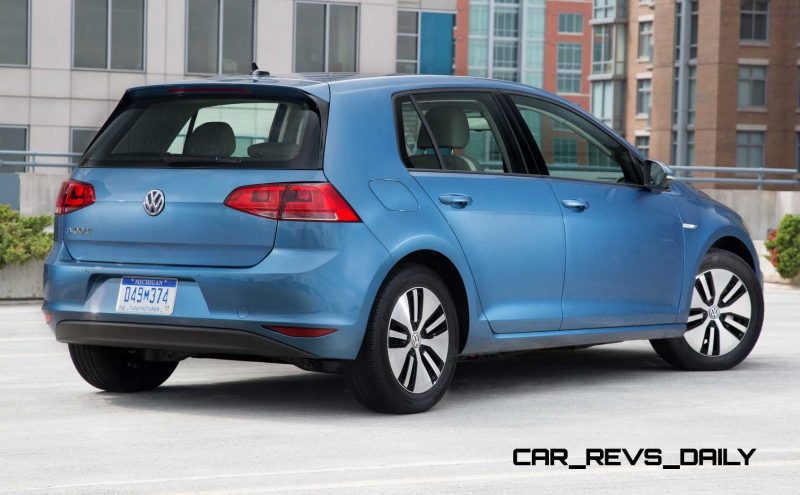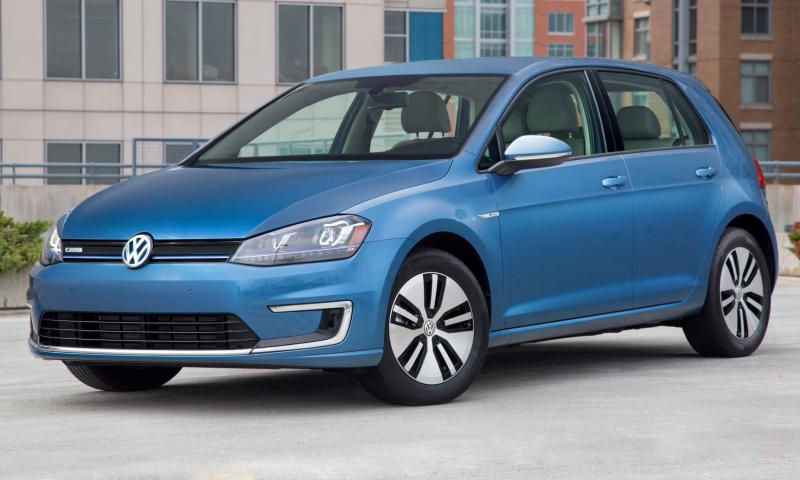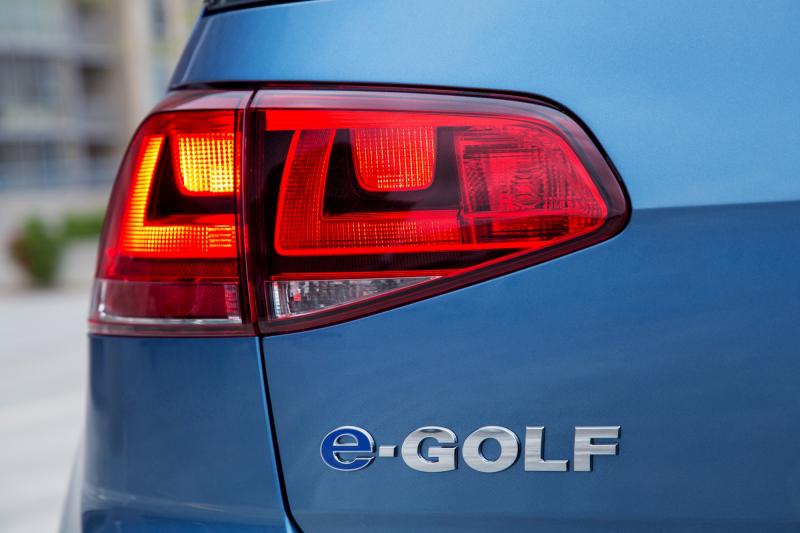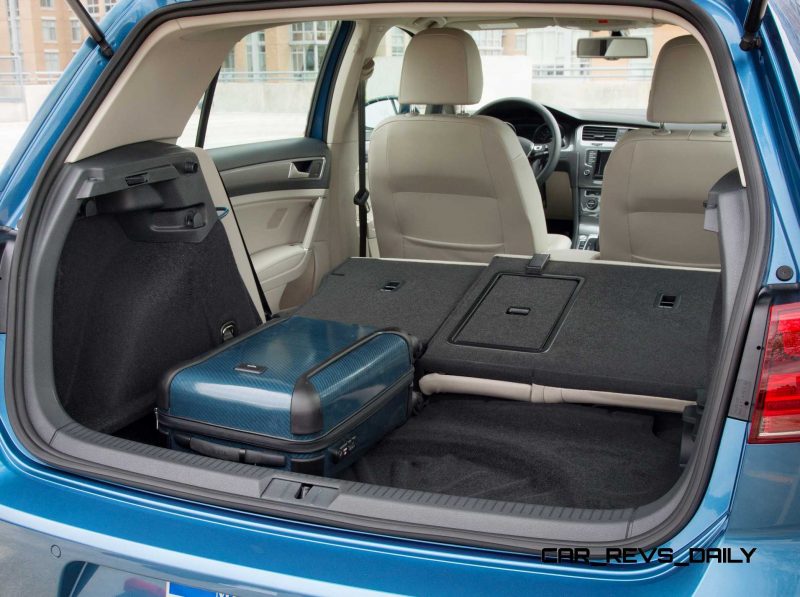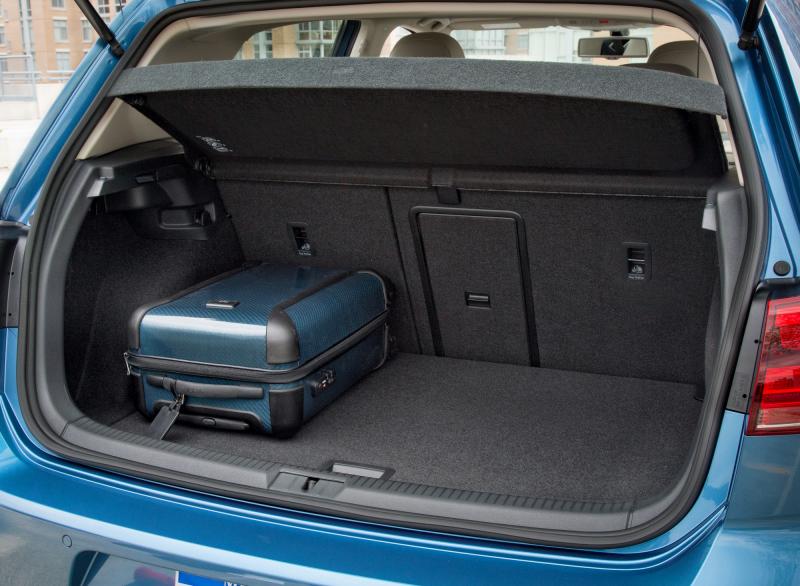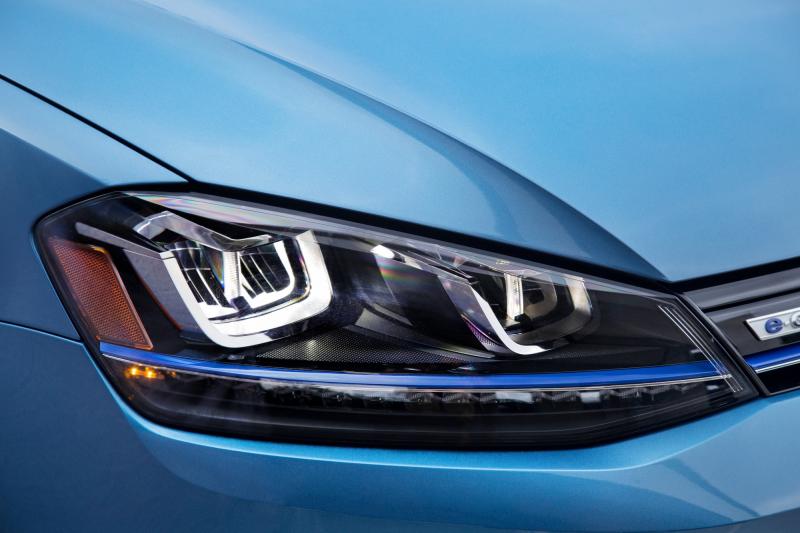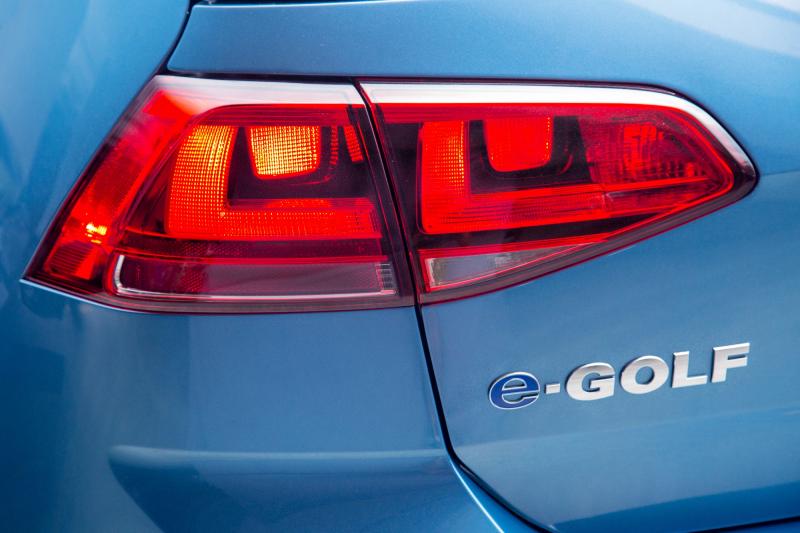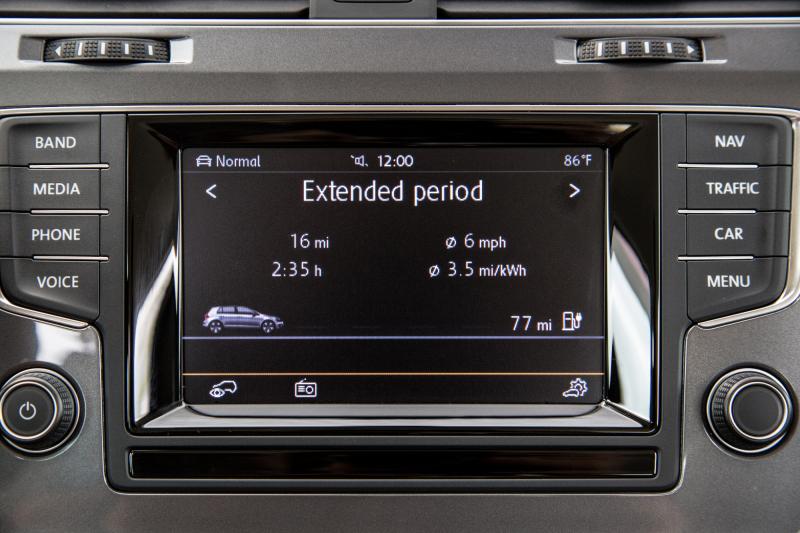The VW e-Golf has come in with a surprisingly affordable price tag: just $35k with few options makes it one of the cheaper full-EV models available, and the cheapest European EV ever to reach US shores. It undercuts the Mercedes-Benz B-Class Electric Drive by more than $10,000 and is clearly benchmarking the Nissan Leaf, its clearest competitor.
The Ford Focus EV recently chopped $7k from its $42,000 pricing strategy — with all non-Tesla EV makers struggling to find shoppers.
Struggling to find shoppers…. at any price, is how that sentence wanted to end. People are not on-board with EV cars’ limited ranges and constant recharging in most areas — but there are exceptions. Atlanta is a huge EV market, and up and down the west coast the sales are about 10X what they are elsewhere in the country.
VOlkswagen is following the buyers, and the e-Golf will only be offered in a handful of non-California/Oregon/Washington markets, most likely aforementioned Atlanta, New York and Washington DC.
So what is special about the e-Golf? It is pretty tame as far as the numbers go, with a 10.5-second sprint to 60-mph and a range of 70 to 90 miles depending on usage and weather, of course. The battery pack is a 24-KwH lithium-ion pack that VW developed inhouse, and points to the e-Golf as a research mission more than anything. The recent Passat GTE concepts have shown a better European-market reception to PHEV models versus full EVs; and this is expected to be the actual way forward outside eco-warrior havens.
Conspicuously absent from Volkswagen’s competitive set is any Prius, which shows how focused the e-Golf is on avoiding regulatory problems. Carmakers simply must have one ultra-low-volume EV model to appease the CARB California laws, and until now have been buying EV credits through a cap/trade program from Nissan and Tesla.
Speaking of Tesla, do they have some wonderful secret in EV success?
Not at all. Despite all the hype, the Model S is actually a great car. As it should be for pricing that is almost always above $100,000. Total volume of the Model S in its three-year lifespan to date is less than 50,000 total units.
If VW sells even 2,000 e-Golfs in calendar 2015, we will eat our hat.
But with pricing this competitive, buyers who demand EV motoring sould jump as VW’s loss-leader. It surely costs nearly twice as much to bring to market.
2015 Volkswagen e-Golf
2015 E-GOLF PRESS KIT
2015 VOLKSWAGEN E-GOLF: VERSATILE, FUN-TO-DRIVE, AND WITH ZERO TAILPIPE EMISSIONS
- The most versatile Electric Vehicle in its class
- Brings zero tailpipe emissions to the fun-to-drive Golf family
- Drivetrain consists of 24.2 kWh lithium-ion battery and an electric motor with 199 pound-feet of torque; 7.2 kW onboard charger is standard
- Holistic approach to e-mobility includes a carbon offset program
- Roadside Assistance Plan helps take the anxiety out of “range anxiety”
- Standard fast charging capability allows 80 percent battery charge within 30 minutes
- First U.S.-market Volkswagen to be fitted with all-LED headlights
- Goes on sale at participating dealers in November, starting at $35,445 for the fully equipped SEL Premium model
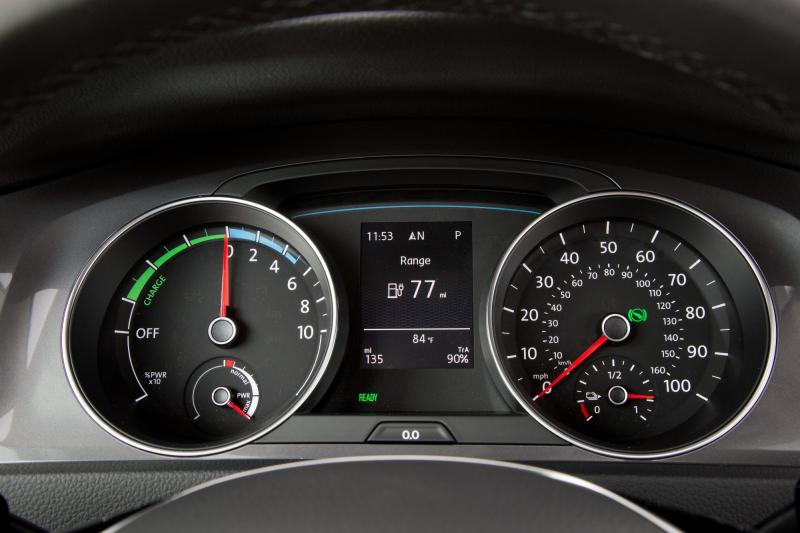
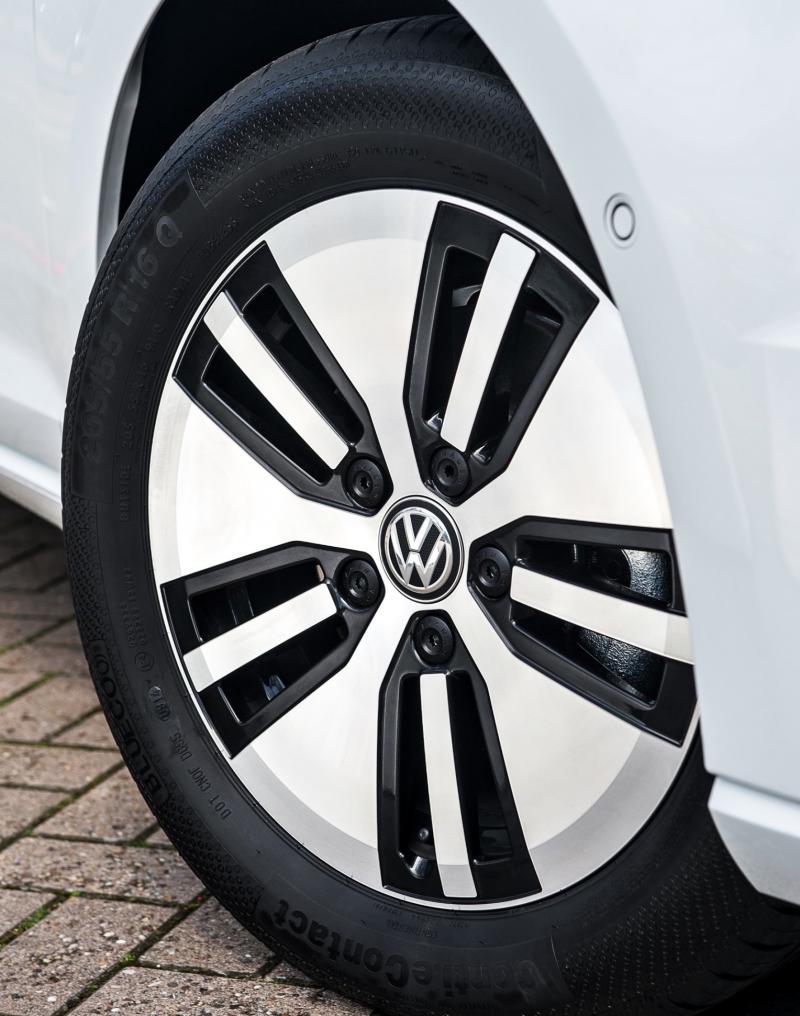
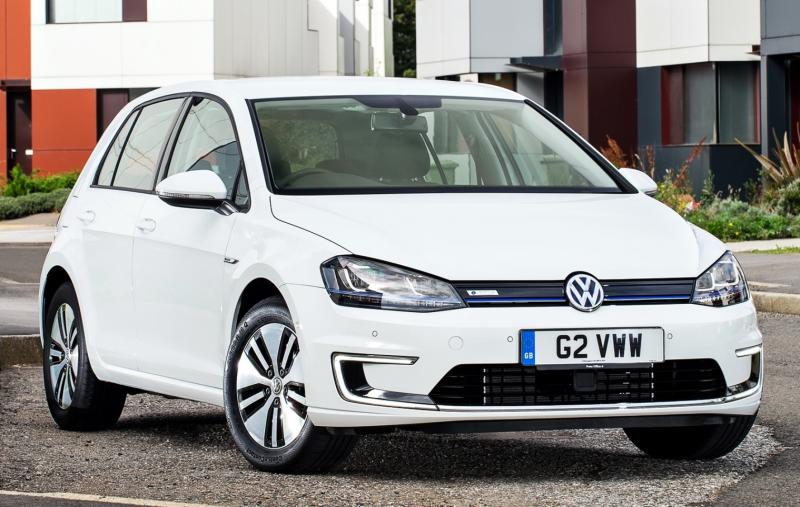
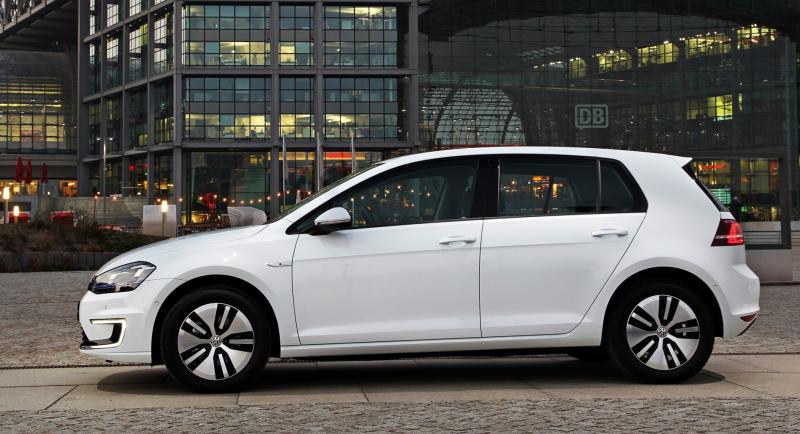
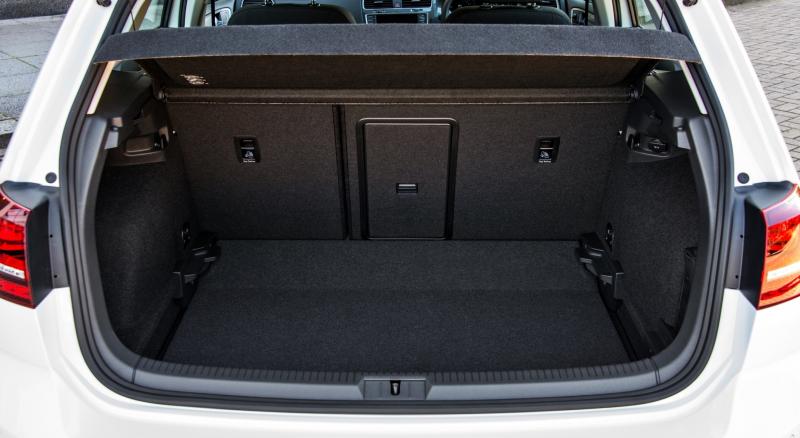
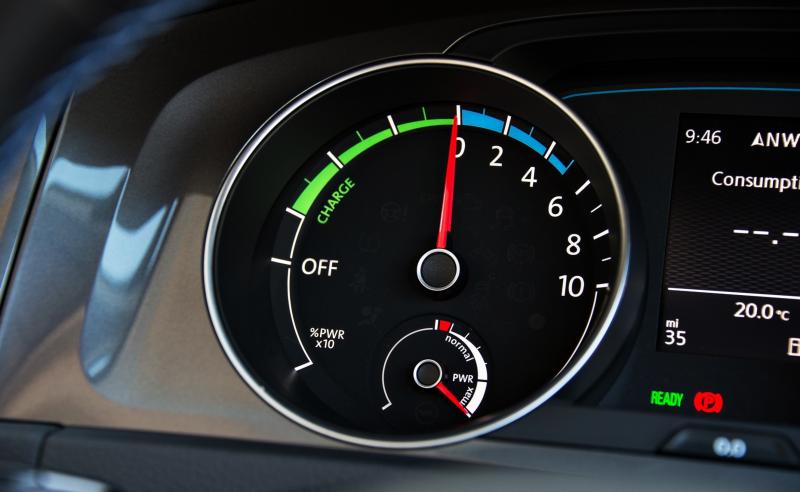
Herndon – The 2015 e-Golf is Volkswagen’s first fully electric vehicle for the U.S. market and joins the burgeoning Golf family of versatile, sporty hatchbacks, starting in November2014 at participating dealers in select states. Although Volkswagen has sold more than 30 million Golf models worldwide, this is the first zero tailpipe emissions, fully electric version of the car. It is also part of Volkswagen’s Think Blue. holistic approach to sustainability and efficiency.
The e-Golf brings all the benefits of an electric vehicle to the Golf’s
“fun-to-drive yet practical” formula, forever ending the idea that compact EVs must be bland and focused only on efficiency. The e-Golf adds a compact electric motor and lithium-ion battery (built in-house at Volkswagen’s Braunschweig facility) to the Golf’s sporty Modular Transverse Matrix (MQB) platform. This modern drivetrain offers zero tailpipe emissions and zero trips to the pump, as well as class-leading torque and interior volume. Depending on driving style, charging behavior, and other factors, the “real world” driving range for the e-Golf is between 70 and 90 miles.
Additionally, Volkswagen is further improving the ownership experience with a groundbreaking and holistic approach to e-Mobility. Volkswagen has announced a collaboration with 3Degrees®, a renewable energy services provider, to invest in carbon reduction projects to help offset the emissions created from production, distribution and charging of the e-Golf for up to approximately 36,000 miles of driving. Charging solutions from Bosch® and Chargepoint®, along with a new Roadside Assistance program and the VW Car-Net® e-Golf app are designed to make owning the e-Golf a thoroughly reassuring, rewarding and enjoyable experience.
The e-Golf will go on sale at participating dealerships in select states this November, starting at $35,445 (plus $820 destination and handling) for the SEL Premium model that features a standard 7.2kW onboard charger, a touchscreen navigation system, a leather-wrapped multifunction steering wheel, dual-zone automatic climate control, and LED headlights.
Exterior
The e-Golf shares the majority of its exterior design with the rest of the new Golf family, which means it has the same sharpened lines and dynamic proportions as the other seventh-generation (A7) models. It is distinguished by some key features, however. The most notable of these is the energy-efficient LED headlights—the very first application of this technology on any Volkswagen vehicle in the United States. These lights offer greater illumination than traditional Bi-Xenon units, yet use less energy doing so. These LED clusters are complemented by C-shaped LED daytime running light strips in the bumper below. Other clues that this is an all-electric VW are the unique badges and blue accents, as well as the obvious lack of any tailpipes at the rear.
Not all of the changes are purely aesthetic, as the e-Golf exterior has some unique functional elements. Great attention has been paid to help maximize the car’s aerodynamic efficiency. The most obvious evidence is the bespoke 16-inch aluminum-alloy wheels which are flushed tightly within the wheelarches, helping ensure airflow is smooth and efficient along the sides of the vehicle. These wheels are wrapped in low rolling resistance, 205-section tires. It doesn’t end with the wheels, however, as the radiator shutter and grille, underbody paneling, rear spoiler and C-pillar air vanes all play a role in helping the e-Golf cut through the air as efficiently as possible. The result of this is an impressive coefficient of drag of just 0.27.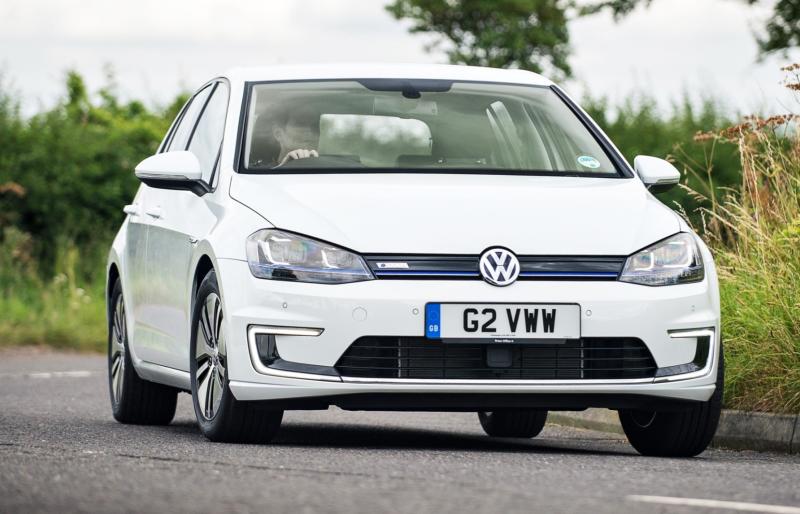
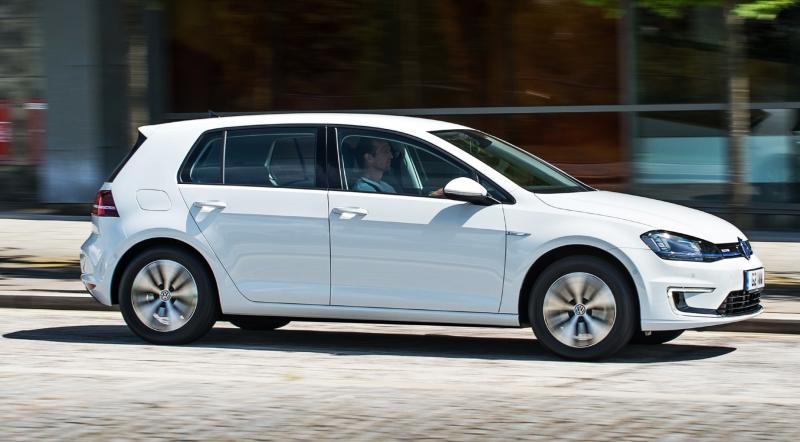
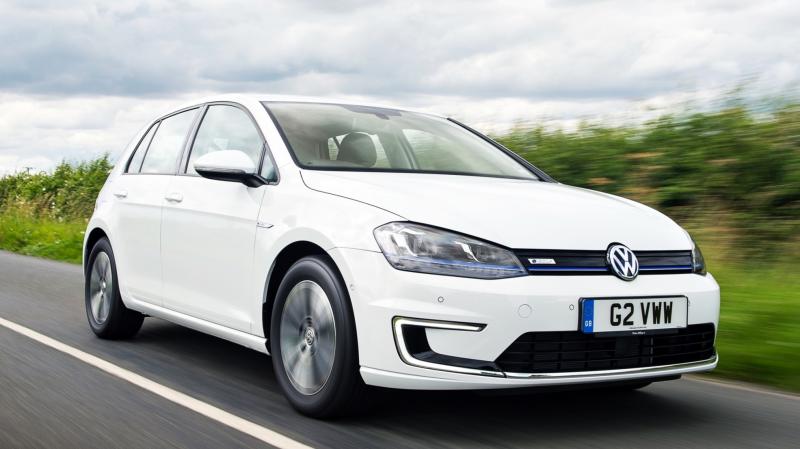

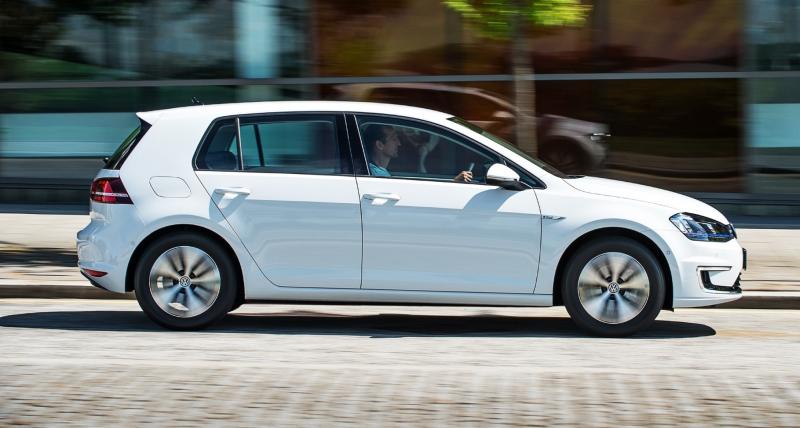
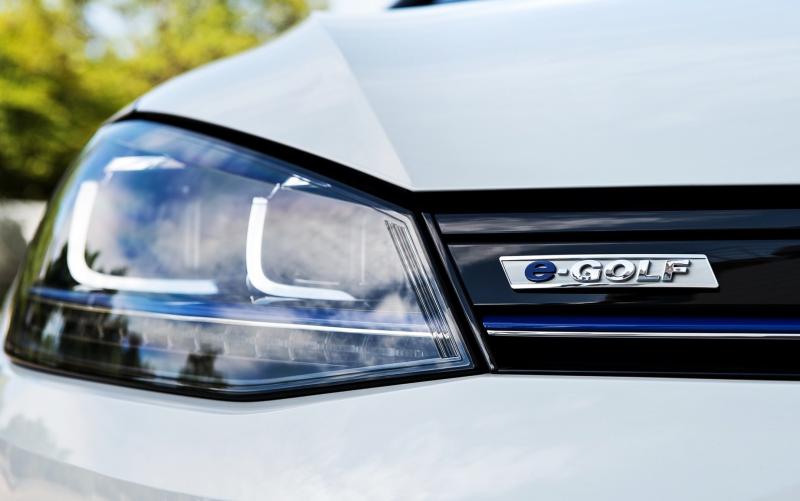
Interior
As with the exterior, the e-Golf features an interior that incorporates common elements found in the rest of the 2015 Golf line as well as several unique features. Despite the large battery pack lying underneath, the e-Golf’s cabin offers exactly the same interior volume as other Golf hatchback models, at an impressive 93.5 cubic feet. It retains the Golf’s highly versatile cargo area, with 22.8 cubic feet of space behind the rear seats and 52.7 cubic feet with the seats folded. Similarly, it features the same use of upscale materials and premium build quality as other Golf models, as well as the updated ergonomics and driver-centric layout.
Great attention has been paid to helping perfect the e-Golf noise levels and acoustics from both inside and out. Without the vibration and noise from a combustion engine, new sources of sound can become more noticeable inside the cabin such as noise from the wind and the tires. In addition, barely perceptible electric drivetrain noises are joined by the sounds of the electrically powered auxiliary components.
To counter this new acoustic profile, Volkswagen has fitted the e-Golf with a low-speed sound system to help alert pedestrians to the vehicle, and has fitted the interior with highly sound-absorbent, lightweight materials to create a cabin space quieter than many luxury vehicles. Further, the electric powerplant’s subframe was changed to a pendulum mount design, which, along with a low-noise motor housing unit, helps to enhance the calm acoustics of the e-Golf, despite the motor’s high torque buildup under acceleration.
Despite the similarities to the standard Golf model, the e-Golf offers an interior feature list that is entirely its own, including aesthetic details like blue accent elements throughout the cabin and decorative seams on the steering wheel and shifter. Perhaps more notably though, the instrument cluster has been redesigned for the electric vehicle’s informational needs, with the traditional tachometer being replaced with a power display that indicates if the motor is ready, if the battery is being recharged (via regenerative braking), or if power is being drawn off—as well as an indicator of available output.
To the right of the power display is a conventional speedometer, although its lower section now shows an indicator of the battery’s current state of charge. Between these two gauges lies a color information display that presents critical data such as the current drive options selected, the estimated driving range, and the remaining estimated charging time and type of charge connection. Since the electric motor doesn’t offer the same auditory and physical signs as a combustion engine when it’s running, a “READY” message appears after the motor has been started.
Launching as a premium model in the Golf lineup, the e-Golf will offer an extremely high level of standard and available equipment, including: a touchscreen navigation system, VW Car-Net® connected services; Keyless access; heatable front seats; a leather-wrapped multifunction steering wheel; Bluetooth® technology; V-Tex leatherette seating surfaces; SiriusXM® Satellite Radio; a rearview camera; and front and rear Park Distance Control.
One of the most significant advances in the new Golf comes in the form of its new touchscreen infotainment center, standard on all models. At 5.8-inches in size, the display utilizes a capacitive touch sensor (as in smartphone and tablet technology) rather than the more common resistive touchscreens that require pressure, enabling gesture controls like swiping and even pinch-zooming.
This infotainment module offers an available SD card-based navigation program complete with 3D rendering, as well as the expected audio functions (including standard SiriusXM® Satellite Radio compatibility) and car analytics and settings. This display also has a proximity sensor function, which senses when a hand is nearby and automatically switches its display to a more finger-friendly layout. The Media Device Interface with iPod® and iPhone® connectivity is now housed in the center stack, while more traditional media such as CDs and SD cards can be inserted into slots in the large glovebox.
Powertrain
The e-Golf is powered by a synchronous permanent-magnet alternating current (AC) motor, dubbed EEM-85, which operates at 12,000 rpm. The compact electric motor sends its power to the front wheels via a single-speed EQ270 transmission; both units were developed in-house and made at Volkswagen’s Kassel components plant. In standard drive mode, it’s capable of delivering a class-leading 199 lb-ft of torque along with 115 horsepower, all the while not using a single drop of fuel and producing zero tailpipe emissions.
Depending on driving style, vehicle settings, charging behavior, and other factors, the manufacturer estimated average “real world” range for the e-Golf is expected to fall between 70 and 90 miles. To help ensure optimal performance in cold weather, a newly developed heat pump system uses both ambient air and heat from the drive system components to warm the cabin rather than relying solely on the high-voltage heater, which can help to reduce on-board electrical consumption, especially in winter driving.
Providing power for the e-Golf electric motor is a lithium-ion battery resting in the center tunnel just ahead of the rear axle and below the rear seats. Thanks to the Modular Transverse Matrix (MQB) flexible architecture, Volkswagen was able to place the large battery within the chassis architecture to eliminate any cabin intrusion or reduction in interior space. The battery is composed of 264 individual prismatic cells, which are efficient enough that the battery doesn’t require any active cooling systems. Co-developed with Panasonic, these cells are integrated in 27 modules of either six or twelve cells each, which collectively produce a nominal rating of 323 volts and an overall capacity of 24.2 kWh. The battery has a limited warranty that covers eight years or 100,000 miles against 70 percent capacity.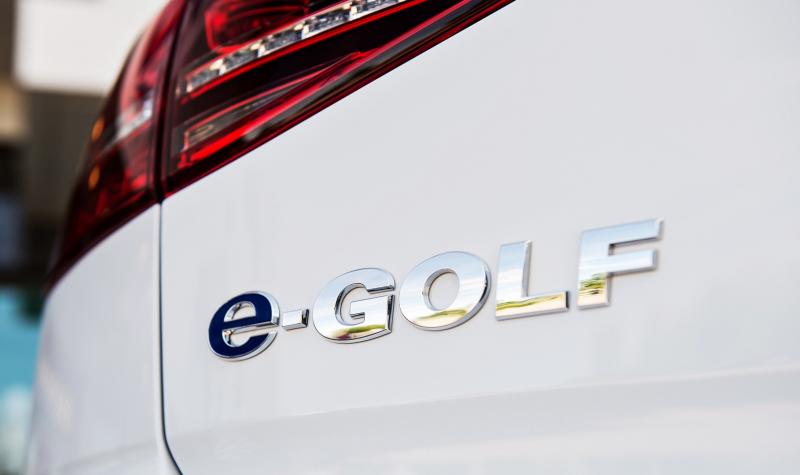

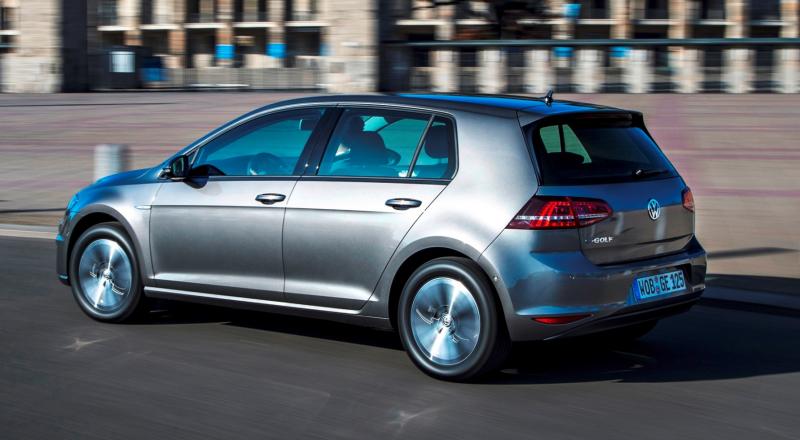
At the front of the battery pack lies the Battery Management Controller (BMC), which has a range of functions, from regular diagnosis and monitoring to helping regulate temperatures in the battery junction controller (the interface to the motor’s energy supply). To combat extreme temperature conditions, the BMC utilizes intelligent thermal control algorithms to help ensure that temperatures within the battery pack remain within a pre-determined range for optimal performance. When the e-Golf is not in use (or in the event of a collision), battery power is automatically shut off.
The e-Golf power electronics module helps control the flow of high-voltage energy between the battery and motor. Depending on the battery voltage (which runs between 250 and 430 volts), the module converts the battery’s store of direct current (DC) energy into alternating current (AC). This unit interfaces with the traction circuit connection to the battery, the three-phase connection to the electric motor, the plug connection from the DC/DC converter to the 12-volt power circuit, and the connection for the high-voltage power distributor.
The e-Golf has a 7.2 kW onboard charger as standard equipment, enabling the EV’s battery to be recharged in any of three ways. While the standard charging cable can plug into any 110/120-volt electrical socket and fully charge the battery in roughly 20 hours, a more optimal solution exists in the 240-volt wallbox that utilizes the full 7.2 kW to charge a battery in less than four hours. The e-Golf comes equipped with a standard Combined Charging System (CCS) which allows the car to use the SAE standard DC fast charging infrastructure (at available stations), which delivers direct power at up to 50 kW, bringing the battery’s state of charge up to 80 percent in approximately 30 minutes. Any of these options provide categorically cheaper ownership costs than fueling a traditional combustion engine.
Innovative driver control
The e-Golf features two technologies that allow the driver to control the vehicle’s energy use: three driving profiles designed to preserve energy (“Normal”, “Eco”, and “Eco+”); and three different levels of regenerative braking (“D1”, “D2”, and “D3”/”B”).
The e-Golf automatically defaults to the “Normal” driving profile, which offers the full horsepower and torque of the electric motor, enabling the e-Golf to reach 60 mph from rest in just over 10 seconds and continue on to an electronically-limited top speed of 87 mph. If greater range is needed, the driver may select from either “Eco” or “Eco+” modes.
In “Eco” mode, maximum power is limited to 94 horsepower and 162 lb-ft, and adjustments are made to the air conditioning system and the response curve of the accelerator pedal. Top speed in “Eco” mode is electronically limited to 72 mph and 0-60 mph performance is approximately 13 seconds.
In “Eco+” mode power output is limited to 74 hp and 129 lb-ft; top speed won’t exceed the electronically limited figure of 56 mph and the accelerator pedal response curve is flattened even further. In addition, the vehicle’s air conditioning is switched off to help maximize efficiency. Regardless of the drive mode selected, however, full accelerator pedal “kick-down” will result in the maximum power and performance of the “Normal” mode.
In addition to the driving modes, the regenerative braking system can also be used to help manage the e-Golf range. There are three driver-selectable levels available: “D1”, “D2”, and “D3”/”B”. By helping to control the amount of energy that can be recuperated from braking, the e-Golf can achieve additional driving range. If the battery is fully charged and the vehicle is in standard “D” mode, no regenerative braking will occur. If you lift off the accelerator pedal or tap the shift lever to the left, the first level of regenerative braking, “D1,” is activated, wherein a small amount of energy is recuperated (and the car is slowed slightly). Levels “D2” and the maximum “D3”/“B” offer increasing levels of energy regeneration.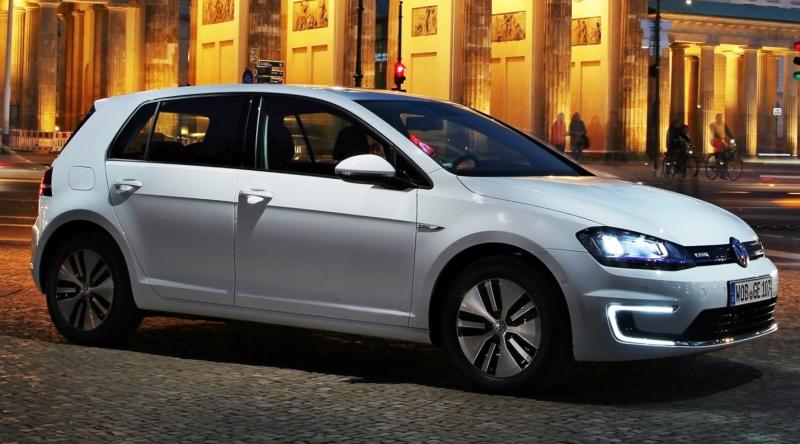
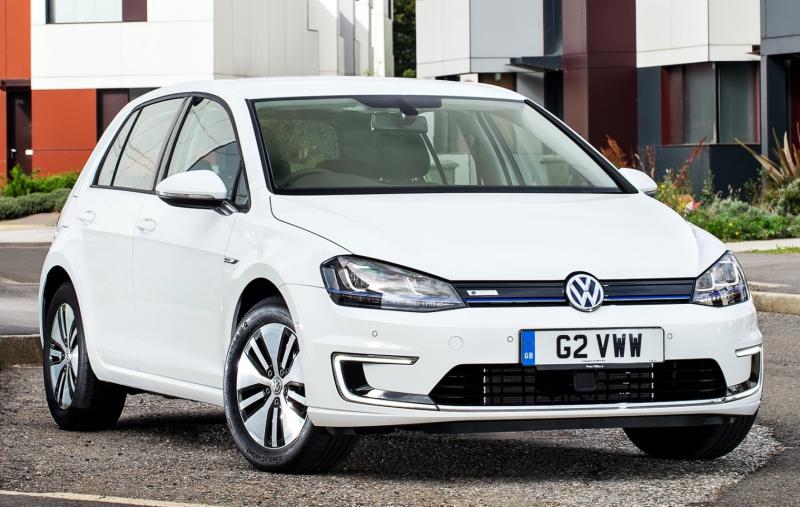
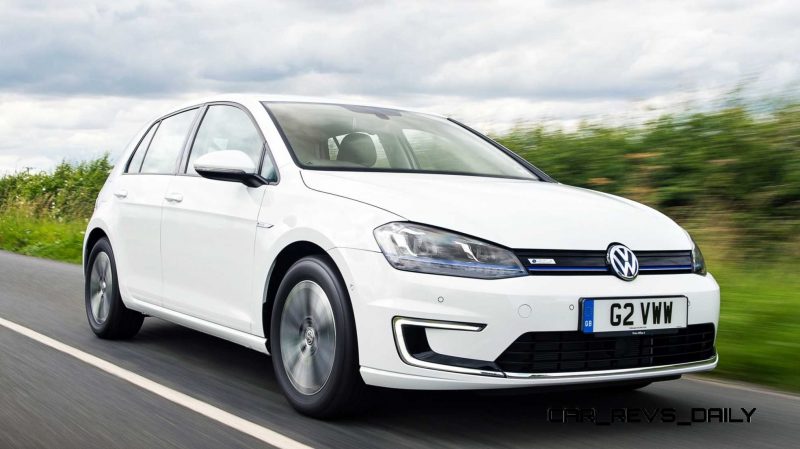
Chassis
The e-Golf shares the same spry MQB chassis architecture as the rest of the line. The unitary construction chassis has two solid-mounted subframes with bolt-on front fenders, and utilizes new technologies such as the laser clamp welder. This produces “wobble seam” welds in a wave pattern to maximize strength in a limited space, offering up to four times the strength of a traditional spot weld.
The e-Golf’s stamped steel body and chassis—like its 2015 Golf counterparts—now boasts 28-percent of its parts in high-strength, hot-formed steel, as opposed to six percent in the previous generation Golf. This technology—along with the use of newly developed ultra-high-strength steels that weren’t available during the last generation’s development and now comprise nine percent of the new Golf’s bodyshell—allows much of the chassis and body to be constructed from thinner and lighter parts without any loss in strength. Thanks to the use of selective thickness for parts, a single component can be tailor-rolled to have as many as 11 zones of varying thicknesses. The upshot is a body-in-white that weighs 51 pounds less than the previous car’s while providing a structure that is 10 percent more torsionally rigid. The e-Golf weighs 3391 pounds, just 368 lb more than a four-door Golf 1.8T automatic model, despite the 701-pound battery.
The e-Golf features a strut-type front suspension with a rear multilink arrangement that has coil springs, telescopic dampers, and an anti-roll bar. The rack-and-pinion steering features electric power assist and features a 13.6 to one ratio that allows for 2.76 turns from lock to lock.
Like all other 2015 Golf models, the e-Golf is equipped with the XDS® Cross Differential System—a feature previously only seen on the performance-oriented GTI model. This technology acts somewhat like an electronic substitute for a traditional mechanical limited-slip differential, working by actively monitoring data from each wheel sensor. If the suspension becomes unloaded, the system automatically applies braking to the driven inside wheel as needed to help reduce understeer (the tendency for the front wheels to run wide). This not only helps the e-Golf’s stability, but also contributes to improved handling and cornering performance.
Safety Systems
Like the rest of the Golf line, the e-Golf provides a combination of both passive and active safety systems. It has been engineered to meet or exceed all current crash regulations and features no fewer than six airbags as standard along with a number of electronic and mechanical driver assistance and safety systems.
Driver Assistance Systems
A new standard driver assistance feature on the e-Golf is Volkswagen’s Automatic Post-Collision Braking system. This builds on the premise that a collision is rarely a single, instantaneous action, but rather a series of events that follow the initial impact—the most significant of which can cause additional collisions. The Automatic Post-Collision Braking system addresses this by applying the brakes when a primary collision is detected by the airbag sensors, thus helping to reduce residual kinetic energy and, in turn, the chance of additional damage.
Customer Experience
Volkswagen’s holistic approach to e-mobility is shown with a complete ownership package for the e-Golf.
- Every buyer can take comfort in the knowledge that their purchase had an impact for the better, since Volkswagen is proud to announce it has teamed with 3Degrees, a renewable energy and carbon offset services provider. The relationship brings new meaning to the idea of a car with a low carbon footprint. By investing in carbon reduction programs, Volkswagen will help offset the e-Golf’s greenhouse gas (GHG) emissions that result from its production, distribution and from the estimated emissions produced from keeping the vehicle charged through the initial 36,000 miles of the vehicle’s life. Volkswagen of America chose to include carbon reduction efforts in California and in Texas with projects geared towards forestry conservation and landfill gas capture.
- As part of Volkswagen’s efforts to deliver an ultra-low-carbon car, the company is also working with SunPower® to provide qualified U.S. Volkswagen e-Golf customers the opportunity to install a high performance SunPower solar system. Volkswagen Group of America is SunPower’s first automotive collaborator and select VW customers will receive premier access to an energy storage solution from SunPower for a limited time once it becomes commercially available. Combining solar with energy storage will help provide homeowners peace-of-mind and opportunity to access back-up power during a power outage.
- When it comes to charging, Volkswagen recently announced that Bosch® Automotive Service Solutions will serve as a charging station and installation services partner for the e-Golf. Bosch® will provide a 240-volt charging unit, the Power Max® charging station, as well as full-service installation for qualified e-Golf drivers. The charging station and installation will be offered at highly competitive prices to e-Golf customers.
- Additionally, Volkswagen has selected ChargePoint® to provide all authorized e-Golf dealerships with charging stations and to give e-Golf drivers access to the largest network of public EV charging stations in the United States. As a result, e-Golf drivers will have access to more than 18,000 ChargePoint stations around the U.S., in addition to those stations installed at authorized VW dealerships. All e-Golf drivers will get access to the ChargePoint mobile app, which will help them navigate to ChargePoint stations, see real-time status updates relating to ChargePoint stations and start charging sessions.
- The e-Golf will also have its own dedicated app, called VW Car-Net e-Golf. This available app allows e-Golf owners to remotely adjust vehicle settings via compatible mobile devices, as well as the VW Car-Net website. Through the app, owners can start (and stop) the car’s climate control system as well as view temperature readings. Similarly, the charging process for the battery can be started, stopped, and set to a time. The e-Manager enables drivers to pre-program up to three departure and charging times. Owners can access a variety of data through the information display on the app, including: miles driven; journey time; estimated electric motor power consumption; estimated power consumption of auxiliary components such as air conditioning and radio; and the use of regenerative braking. Owners can even simply check the status of the car’s door and trunk locks, lights, charging cable or GPS location.
- Finally, Volkswagen’s Roadside Assistance Plan is designed to take the potential stress out of planning around the range limits of an EV. For instance, if the e-Golf runs out of charge within 100 miles of the owner’s home, Volkswagen will arrange for the car to be delivered to a nearby, convenient source for charging, as well as pay any taxi or transportation fees for the owner.
Limited Warranty and Scheduled Maintenance
The 2015 e-Golf is offered with Volkswagen’s five-year/60,000-mile (whichever occurs first) powertrain limited warranty and three-year/36,000-mile (whichever occurs first) new vehicle limited warranty. The e-Golf also has a battery limited warranty that covers eight years or 100,000 miles against 70 percent capacity. E-Golf owners should see their VW dealers for more information about these limited warranties. In addition, a three-year/36,000-mile roadside assistance program is standard, as is the one-year/10,000-mile Carefree Maintenance® Program that covers the vehicle’s first scheduled maintenance during this period, at no extra charge.
Model Line-up
e-GOLF SEL Premium
With a starting price of $35,445 (plus $820 destination and delivery), the e-Golf brings a high level of standard equipment to the compact EV class. Standard features include: LED headlights and LED DRLs; a 7.2 kW onboard charger; 16-inch aluminum-alloy wheels; a heat pump; a touchscreen navigation and infotainment system; Sirius XM® Satellite Radio; a Media Device Interface (MDI) with iPod® integration; Bluetooth® connectivity; VW Car-Net connected services; V-tex leatherette seating surfaces; leather-wrapped multifunction steering wheel and shifter knob; heatable front seats; Climatronic® dual zone automatic climate control; front and rear Park Distance Control; rearview camera; and rain-sensing windshield wipers
Competitive Set
Chevrolet Volt
Ford Focus EV
Nissan Leaf
About Volkswagen of America, Inc.
Founded in 1955, Volkswagen of America, Inc., an operating unit of Volkswagen Group of America, Inc. (VWoA) is headquartered in Herndon, Virginia. It is a subsidiary of Volkswagen AG, headquartered in Wolfsburg, Germany. VWoA’s operations in the United States include research and development, parts and vehicle processing, parts distribution centers, sales, marketing and service offices, financial service centers, and its state -of-the- art manufacturing facility in Chattanooga, Tennessee. The Volkswagen Group is one of the world’s largest producers of passenger cars and Europe’s largest automaker. VWoA sells the Beetle, Beetle Convertible, CC, Eos, e-Golf, Golf, Golf R, GTI, Jetta, Jetta SportWagen, Passat, Tiguan and Touareg vehicles through approximately 644 independent U.S. dealers. Visit Volkswagen of America online at www.vw.com or media.vw.com to learn more.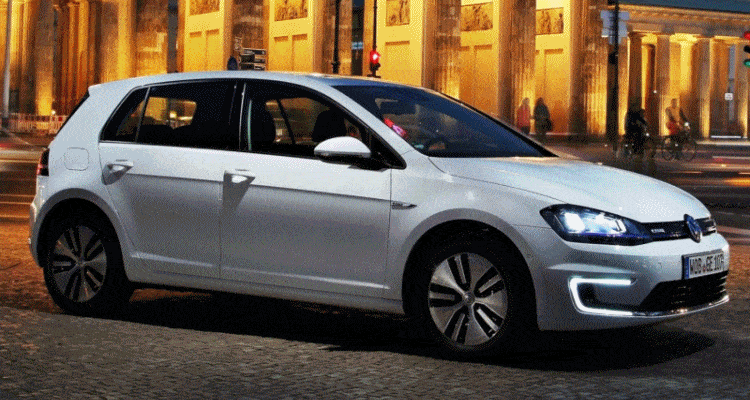
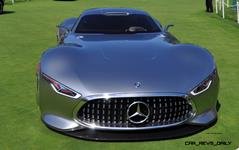
Tom Burkart is the founder and managing editor of Car-Revs-Daily.com, an innovative and rapidly-expanding automotive news magazine.
He holds a Journalism JBA degree from the University of Wisconsin – Madison. Tom currently resides in Charleston, South Carolina with his two amazing dogs, Drake and Tank.
Mr. Burkart is available for all questions and concerns by email Tom(at)car-revs-daily.com.


